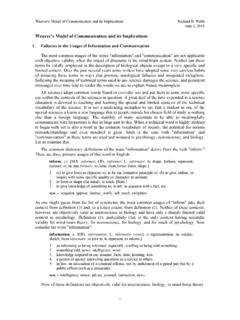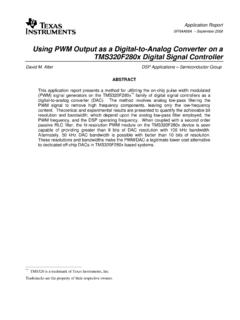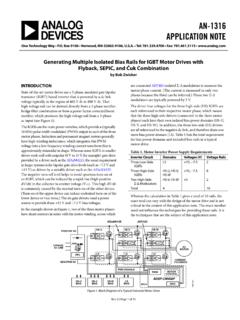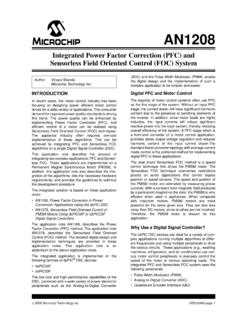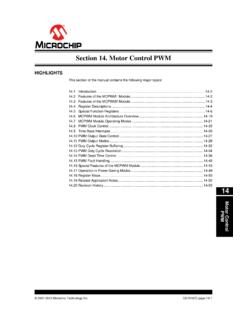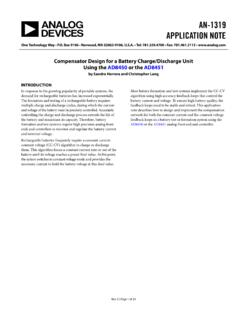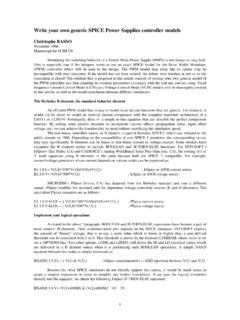Transcription of Project 10: Frequency Measurement Using Input …
1 FFrreeqquueennccyy MMeeaassuurreemmeenntt UUssiinngg IInnppuutt CCaappttuurree wwiitthh tthhee CCeerreebboott MMXX77ccKK Revision: 07 Dec 2017 (JFF) Richard W. Wall, University of Idaho, 1300 NE Henley Court, Suite 3 Pullman, WA 99163 (509) 334 6306 Voice | (509) 334 6300 Fax page 1 of 18 Project 10: Frequency Measurement Using Input Capture Project 10: Frequency Measurement Using Input Capture .. 1 Purpose .. 2 Minimum Knowledge and Programming Skills .. 2 Equipment List .. 2 Software Resources .. 2 References .. 3 analog to Digital 3 Fundamentals of Frequency Measurement .. 4 Timer Setup for PWM and Input Capture .. 6 PIC32 Software for Timer 2 Setup for PWM and Timer Interrupt.
2 7 PIC32 Software Timer Setup for Input Capture .. 8 Project Tasks .. 9 Project Specifications .. 10 Project Testing .. 12 Frequency Measurement Using Input Capture with the Cerebot MX7cK page 2 of 18 Appendix A: Project 10 Parts Configuration .. 15 Appendix B: Motor Controller Wiring Diagram .. 15 Appendix C: PMod HB5 Half H-Bridge Drive .. 16 Appendix D: Geared DC Motor .. 16 Appendix E: PmodCLP .. 17 Appendix F: Period Measurement Resolution .. 17 Purpose The purpose of this Project is to use the PIC32 Input capture to measure Frequency . Using such a Frequency Measurement will allow us to determine the speed of a DC motor. This Project uses a period Measurement to determine Frequency .
3 Project 9 should be completed prior to completing Project 10. Minimum Knowledge and Programming Skills 1. Knowledge of C or C++ programming 2. Working knowledge of MPLAB X IDE 3. Understanding of PWM principles 4. Concepts of Frequency measurements (bad link!) 5. Use of logic analyzer (7 channels will be simultaneously monitored) Equipment List 1. Digilent Cerebot MX7cK processor board with USB cable 2. Microchip MPLAB X IDE 3. Microchip MPLAB XC32 Compiler 4. Digilent PmodCLP Parallel Character LCD 5. Digilent H-Bridge driver PMod 6. Digilent DC Motor 7. 8 Channel Logic analyzer (Digilent analog Discovery) Software Resources Frequency Measurement Using Input Capture with the Cerebot MX7cK page 3 of 18 1.
4 XC32 C/C++ Compiler Users Guide 2. PIC32 Peripheral Libraries for MBLAB C32 Compiler 3. PIC32 Family Hardware Reference Manual Section 16 output Compare 4. Cerebot MX7cK Board Reference Manual 5. MPLAB X Integrated Development Environment (IDE) References 1. PIC32 Input Capture 2. Voltage to Frequency Converter 3. Using PWM to generate analog output 4. C Programming Reference analog to Digital Conversion Project 9 investigated methods of Using a microprocessor to generate a variable amplitude output . In Project 10, we will look at one method of Using a microprocessor to measure a variable-valued Input . The PIC32 processor has 16 analog inputs channels for a 10-bit ADC.
5 However, we will use the DC motor tachometer to measure the analog speed value. Considering that the motor speed is controlled by the average applied voltage, the tachometer represents a voltage to Frequency converter. Various silicon manufacturers offer electronic devices that are used to generate a pulse waveform whose Frequency is a function of the voltage applied to the sensor Input . Using the Frequency of a digital pulse wave to represent an analog signal has the advantages of higher signal to noise ratio and reduces sensitivity to circuit impedance. Project 9 implemented open loop speed control of a DC motor. This control approach depends upon the proportionality of the motor speed to the applied voltage.
6 Project 10 is designed to test the linearity of open loop speed control by providing a tachometer to measure the rotor shaft speed. The hardware requirements for Project 9 are the same as for Project 10. Details concerning the hardware configuration for this Project are provided in Appendix A through Appendix E. The DC motor used on the Digilent Cerebot MX7cK Project System pictured in Appendix D has two Hall Effect sensors that provide a pulse each time the DC motor shaft makes a revolution. The two sensors are physically oriented around the motor rotor shaft such that they generate two digital signals that oscillate at the same Frequency but are out of phase by 90 degrees.
7 The SA and SB PmodHB5 Hall Effect sensor outputs form a quadrature encoder that allows both the speed and direction of rotation to be measured. We are only concerned with measuring the motor speed in Project 10. Frequency Measurement Using Input Capture with the Cerebot MX7cK page 4 of 18 The speed of the geared output shaft is reduced by the ratio of 53 to 1 to provide greater mechanical torque. The speed of the motor will be measured by determining the Frequency of the digital pulse wave generated by the Hall Effect sensor. Fundamentals of Frequency Measurement As with the Measurement of any data, we are concerned with three parameters: accuracy, resolution, and precision.
8 The accuracy of a Frequency Measurement is dictated, to a large extent, by the accuracy of the reference crystal or oscillator. For this Project , we depend on the accuracy of the oscillator populated on the Cerebot MX7cK processor board. The Measurement precision is a metric applied to the repeatability of a Measurement . Resolution is the smallest interval between two measurements. Accuracy is the difference between the measured value and an absolute standard (the truth ). Measurement precision and resolution are determined by the processing of the measured data. The subject of Frequency Measurement resolution is of great interest and is addressed in greater detail in the following paragraphs.
9 There are two methods of estimating the Frequency of the tachometer. The number of signal transitions (rising, falling, or both) in a fixed time interval can be counted, or the time interval between two consecutive signal transitions can be measured Using a timer. Measuring Frequency by counting transitions over short intervals is more accurate for signals when the Frequency of the signal being measured is high relative to the observation interval. This results in many hundreds or even thousands of cycles being counted during the Measurement interval, thus providing a high Frequency Measurement resolution. Measuring the period is generally more precise for relatively low Frequency signals.
10 The resolution is provided by the number of timer counts between Input signal transitions. The Measurement period now depends of the Frequency of the Input signal and, for very low Frequency signals, may result in excessively long delays between Measurement updates. There are methods to mitigate the effects of long Measurement periods for low Frequency signals. One method is to use Frequency multiplication with a phased locked loop (PLL) circuit. Most modern microcontrollers and microprocessors use Frequency multiplication so that the core speed of the processor is many times the processor crystal Frequency . The PIC32 processor family uses a phase locked loop multiplier to set the core Frequency by a parameter in the file.
